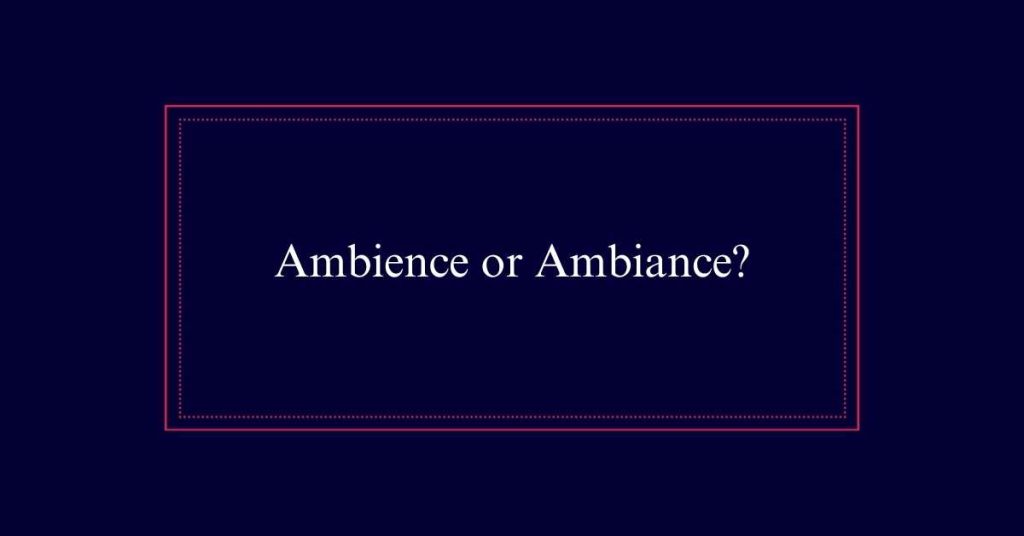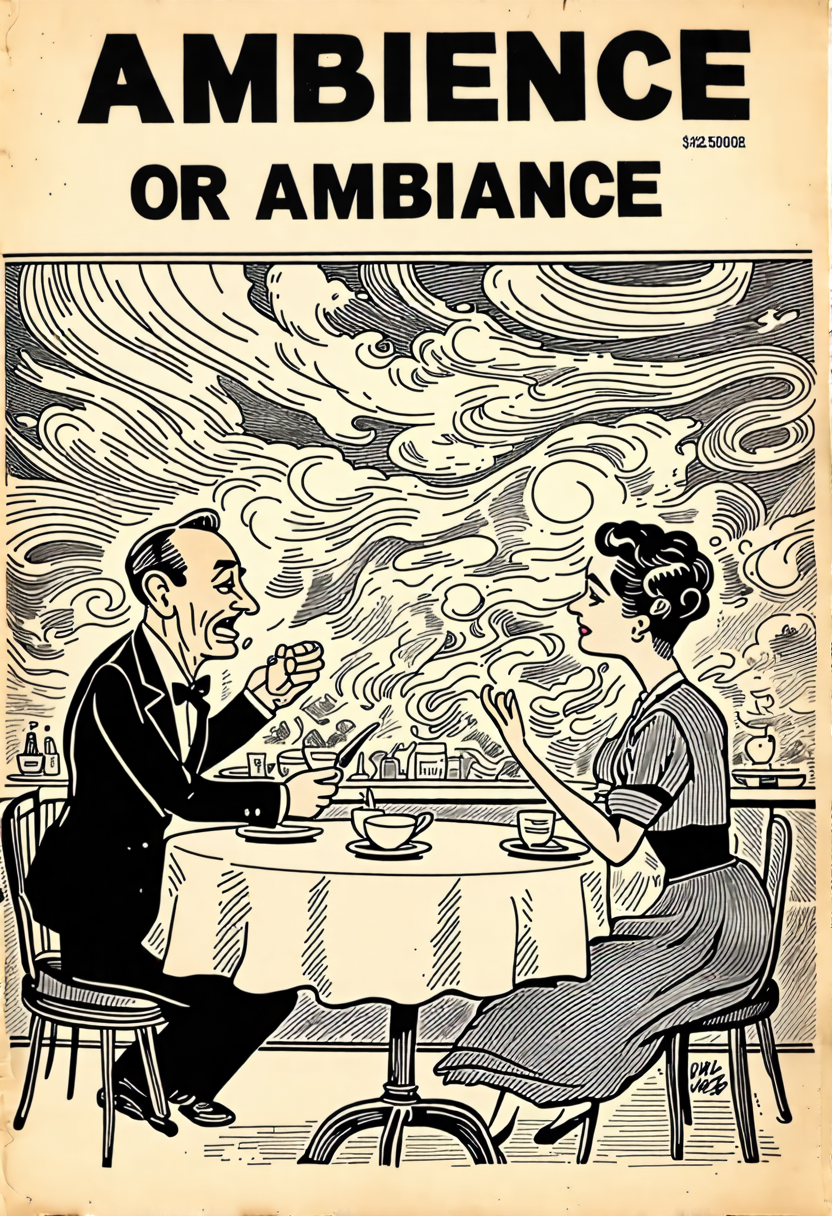Ambience or Ambiance?
Both ‘ambience’ and ‘ambiance’ are correct spellings. The term originates from the French word ‘ambiant,’ referring to the mood or atmosphere of a place. While ‘ambience’ is more commonly used in English, ‘ambiance’ remains an accepted alternative, often perceived as slightly more formal or French. Core elements like lighting, sound, and decor contribute to this atmosphere.
Origins of Ambience
The term ‘ambience’ originates from the French word ‘ambiant,’ meaning surrounding. This etymology reflects the concept’s focus on the elements that envelop a space.
Historically, it has been used to describe the general mood or atmosphere of an environment. Factors contributing to ambience include music, paint color, conversation volume, and odors. These elements interact to create a particular feeling or vibe in a location.
While ‘ambience’ is the older spelling, ‘ambiance’ also appears in English usage. Both spellings are correct and interchangeable. The choice between them often depends on personal or stylistic preference.
Definition and Meaning
Ambience refers to the mood or atmosphere of a particular environment. It encapsulates the overall feeling or character that a place exudes. This term is widely used to describe the sensory experiences that contribute to the perception of a location.
Key elements that define ambience include:
- Lighting: Bright or dim lighting can set different moods.
- Sound: Background music or noise levels impact the atmosphere.
- Decor: The choice of furniture and décor can influence the vibe.
- Temperature: The warmth or coolness of a place affects comfort.
Ambience, derived from the French word meaning ‘surrounding,’ is a versatile term applicable to various settings. Its alternative spelling, ambiance, offers the same meaning, allowing flexibility in usage.
Factors Influencing Ambience
Several elements greatly influence the ambience of a place, creating distinct sensory experiences. Lighting plays a pivotal role; soft, warm lights can create a cozy atmosphere, while bright, cool lights can energize a space.
Music adds another layer, with different genres setting various moods. Paint color impacts perception, with hues like blue promoting calm and red evoking energy. The volume of conversation can either make a place feel lively or tranquil.
Smells also contribute greatly; pleasant scents like lavender can relax, while citrus can invigorate. Each of these factors works together to shape the overall feeling of an environment, making ambience a multifaceted concept that engages multiple senses.

Ambience Vs. Ambiance
Both ‘ambience’ and ‘ambiance’ are correct spellings, each offering a nuanced choice for writers. The preference between the two often depends on individual style and context.
Ambience’ is the more commonly used spelling in English, while ‘ambiance’ retains a slightly more formal or French flair. Both terms describe the mood or atmosphere of a setting.
Key points to take into account:
- ‘Ambience’ is more frequently used in general English.
- ‘Ambiance’ may be chosen for its stylistic or cultural connotations.
- Both spellings are accepted and understood by readers.
- Writers should remain consistent in their choice throughout a piece.
Historical Usage
Throughout history, the terms ‘ambience’ and ‘ambiance’ have evolved in their usage and acceptance. ‘Ambience’ is derived from the French word for surrounding and has been the older spelling in English.
Over time, both spellings have been used to describe the mood or atmosphere of a place. Literary examples from different eras show that writers have employed both forms interchangeably.
‘Ambience’ became more commonly accepted, while ‘ambiance’ remained an alternative. The evolution of these terms reflects changes in language and cultural preferences.
Common Usage Today
In contemporary writing, ‘ambience’ is more frequently used than ‘ambiance’ to describe the mood or atmosphere of a place. This preference is evident across various forms of media, including blogs, articles, and reviews. The word ‘ambience’ is often chosen for its familiarity and ease of recognition.
- ‘Ambience’ appears more often in modern text.
- Both spellings are correct and interchangeable.
- ‘Ambiance’ is sometimes seen in artistic contexts.
- Usage may depend on regional preferences.
Examples in Literatur
Literary works often feature both ‘ambience’ and ‘ambiance’ to set the mood or atmosphere of a scene.
For instance, in classic literature, the term ‘ambience’ might describe the haunting mood in Gothic novels. Contemporary authors, however, may prefer ‘ambiance’ to evoke a sophisticated setting in modern narratives. Both spellings are found in poetry, where the context and rhythm dictate the choice.
Famous writers like Charles Dickens and F. Scott Fitzgerald have used ‘ambience’ to describe a setting’s character. Meanwhile, modern authors like Haruki Murakami might choose ‘ambiance’ to add a cosmopolitan flair.
Personal Preference
Writers often lean towards their preferred spelling, whether ‘ambience’ or ‘ambiance’, based on personal taste. This decision is usually influenced by:
- Aesthetic Appeal: Some find ‘ambience’ visually pleasing, while others prefer ‘ambiance’.
- Consistency: Writers may choose a spelling they have consistently used in past works.
- Cultural Influence: Regional preferences can affect which spelling feels more natural.
- Audience Expectation: Knowing the audience’s familiarity with one spelling over the other can guide the choice.
Popularity and Influence
The prevalence of the spelling ‘ambience’ over ‘ambiance’ is evident in many contemporary texts. This preference is influenced by the widespread use of ‘ambience’ in modern literature, media, and everyday communication. Various factors contribute to this trend, including regional differences and historical usage patterns.
| Aspect | Details |
|---|---|
| Literary Usage | ‘Ambience’ is more frequently used in books and articles. |
| Media | News outlets and blogs prefer ‘ambience’. |
| Regional Trends | ‘Ambience’ is favored in British English. |
| Historical Usage | ‘Ambience’ has a longer history in English usage. |
Impact on Tone
Choosing between ‘ambience’ and ‘ambiance’ can subtly influence the tone of a written piece. The spelling ‘ambience’ often feels more traditional and grounded, while ‘ambiance’ can add a touch of sophistication and elegance. The choice can affect how the reader perceives the atmosphere described.
- Traditional vs. Modern:
‘Ambience’ conveys a classic tone, while ‘ambiance’ feels more modern.
- Formality:
‘Ambiance’ might be perceived as more formal or refined.
- Consistency:
Maintaining a consistent spelling choice helps in keeping the tone steady.
- Audience:
Consider the audience; some may prefer the simplicity of ‘ambience’, others the elegance of ‘ambiance’.







